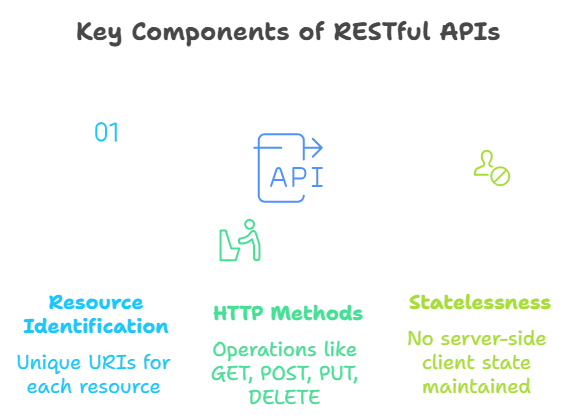RESTful APIs in Go
REST (Representational State Transfer) is an architectural style for designing networked applications. RESTful APIs in Go enable communication between clients and servers over HTTP using standard CRUD (Create, Read, Update, Delete) operations. In this chapter, we'll explore the fundamentals of building RESTful APIs in Go, covering basic concepts, implementation techniques, and advanced features.
Understanding RESTful Principles
Resource Identification: RESTful APIs operate on resources, which are identified by URIs (Uniform Resource Identifiers). Each resource should have a unique URI.
HTTP Methods: RESTful APIs use HTTP methods (GET, POST, PUT, DELETE) to perform CRUD operations on resources. Each method has a specific purpose: GET for retrieving data, POST for creating data, PUT for updating data, and DELETE for deleting data.
Statelessness: RESTful APIs are stateless, meaning each request from a client must contain all the information necessary to process that request. The server does not maintain any client state between requests.

Basic Implementation of RESTful APIs
Setting Up a Go Project: Start by creating a new Go module and installing necessary packages.
mkdir myapi
cd myapi
go mod init github.com/myusername/myapi
Creating a Basic API Endpoint: Define a simple HTTP server with an endpoint to handle GET requests.
package main
import (
"net/http"
)
func main() {
http.HandleFunc("/hello", func(w http.ResponseWriter, r *http.Request) {
w.WriteHeader(http.StatusOK)
w.Write([]byte("Hello, World!"))
})
http.ListenAndServe(":8080", nil)
}
Routing
Routing is the process of directing incoming requests to the appropriate endpoint handlers based on the request’s URI and HTTP method. Efficient routing ensures that your API can handle various endpoints and HTTP methods seamlessly. Libraries like Gorilla Mux provide powerful routing capabilities in Go by allowing you to define complex routing patterns, handle route parameters, and implement middleware for route-specific operations.
// Define a router using Gorilla Mux
router := mux.NewRouter()
// Define routes
router.HandleFunc("/users", getUsers).Methods("GET")
router.HandleFunc("/users/{id}", getUserByID).Methods("GET")
router.HandleFunc("/users", createUser).Methods("POST")
router.HandleFunc("/users/{id}", updateUser).Methods("PUT")
router.HandleFunc("/users/{id}", deleteUser).Methods("DELETE")
// Start the HTTP server with the router
http.ListenAndServe(":8080", router)
Data Persistence:
Data persistence involves storing and retrieving data from a database, enabling your API to interact with persistent data. Popular choices for databases in Go include PostgreSQL, MySQL, and MongoDB. Integrating a database into your Go application allows you to store and manage data effectively, facilitating CRUD operations and data manipulation.
// Connect to the PostgreSQL database
db, err := sql.Open("postgres", "user=postgres password=postgres dbname=mydb sslmode=disable")
if err != nil {
log.Fatal(err)
}
defer db.Close()
// Query the database
rows, err := db.Query("SELECT id, name FROM users")
if err != nil {
log.Fatal(err)
}
defer rows.Close()
// Iterate over the query results
for rows.Next() {
var id int
var name string
if err := rows.Scan(&id, &name); err != nil {
log.Fatal(err)
}
fmt.Printf("ID: %d, Name: %s\n", id, name)
}
Authentication and Authorization:
Authentication verifies the identity of users accessing your API, while authorization determines whether a user has the necessary permissions to perform certain actions on resources. Implementing authentication and authorization mechanisms such as JSON Web Tokens (JWT) allows you to secure your API endpoints and restrict access based on user roles and permissions.
// Generate a JWT token
token := jwt.New(jwt.SigningMethodHS256)
claims := token.Claims.(jwt.MapClaims)
claims["username"] = "user123"
claims["role"] = "admin"
claims["exp"] = time.Now().Add(time.Hour * 24).Unix()
signedToken, err := token.SignedString([]byte("secret"))
if err != nil {
log.Fatal(err)
}
// Validate a JWT token
tokenString := "eyJhbGciOiJIUzI1NiIsInR5cCI6IkpXVCJ9..."
token, err := jwt.Parse(tokenString, func(token *jwt.Token) (interface{}, error) {
return []byte("secret"), nil
})
if err != nil {
log.Fatal(err)
}
if token.Valid {
fmt.Println("Valid token")
} else {
fmt.Println("Invalid token")
}
Best Practices and Conventions:
Use Meaningful URIs: Design URIs that accurately represent the resources they identify. Follow a consistent naming convention to make your API endpoints intuitive and easy to understand.
Versioning: Consider versioning your APIs to maintain backward compatibility and support future updates. Versioning allows you to introduce changes without breaking existing clients’ functionality.
Error Handling: Implement clear and informative error messages to help clients troubleshoot issues effectively. Use appropriate HTTP status codes and provide additional details in the response body to indicate the nature of the error.
Building RESTful APIs in Go is a fundamental aspect of modern web development. By adhering to RESTful principles, implementing basic endpoints, leveraging advanced features, and following best practices, you can create robust and scalable APIs to power your applications. Experiment with different techniques, explore additional libraries and tools, and continuously refine your API design to meet the evolving needs of your users. Happy coding !❤️
